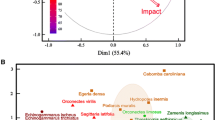Abstract
This article describes an application of a method for assessing risks associated with the introduction of an organism into a new environment. The test organism was a binucleate Rhizoctonia fungal isolate that has potential for commercial development as a biological control agent for damping-off diseases in bedding plants. A test sample of host plant species was selected using the centrifugal phylogenetic host range principles, but with an emphasis on economic species. The effect of the fungus on the plant was measured for each species and expressed on a logarithmic scale. The effects on weights of shoots and roots per container were not normally distributed, nor were the effects on the number of plants standing (those which survived). Statements about the effect on the number standing and the shoot weight per container involved using the observed (empirical) distribution. This is illustrated with an example. Problems were encountered in defining the population of species at risk, and in deciding how this population should be formally sampled. The limitations of the method are discussed.
Similar content being viewed by others
REFERENCES
M. D. de Jong, P. C. Scheepens, and J. C. Zadoks, "Risk Analysis for Biological Control: A Dutch Case Study in Bio-control of Prunus serotinaby the Fungus Chondrostereum purpureum," Plant Dis. 74189-194 (1990).
M. L. Gullino, Q. Migheli, and M. Mezzalama, "Risk Analysis in the Release of Biological Control Agents: Antagonistic Fusarium oxysporumas a Case Study," Plant Dis. 791193-1201 (1995).
M. H. Ryder and R. L. Correll, "Assessing the Potential Bene-fits and Risks of Introducing Natural and Genetically Manipu-lated Bacteria for the Control of Soil-borne Root Diseases," in H. T. Hokkanen and J. M. Lynch (eds.), Biological Control: Benefits and Riskspp. 209-216 (Cambridge University Press, Cambridge, UK, 1995).
G. Suter, "Exotic Organisms," in G. W. Suter II (ed.), Ecologi-cal Risk Assessmentpp. 391-402, (Lewis Publishers, Chelsea, Michigan, 1993).
A. R. Harris, D. A. S chisler, and M. H. Ryder, "Binucleate RhizoctoniaIsolates Control Damping-off Caused by Pythium ultimumvar. sporangiiferumand Promote Growth, in Capsi-cumand CelosiaSeedlings in Pasteurized Potting Medium," Soil Biol.Biochem. 25909-914 (1993).
A. R. Harris, D. A. Schisler, S. M. Neate, and M. H. Ryder, "Suppression of Damping-off Caused by Rhizoctonia solaniand Growth Promotion, in Bedding Plants by Binucleate Rhi-zoctoniaSpp," Soil Biol.Biochem. 26263-268 (1994).
G. J. Weidemann, "Host Range Testing: Safety and Science," in D. O. TeBeest (ed.), Microbial Control of Weedspp. 83-96 (Chapman and Hall, New York, 1991).
A. R. Harris, D. A. Schisler, and S. M. Neate, "Culture of Rhizoctonia solaniand Binucleate RhizoctoniaSpp on Organic Substrates for Inoculation of Seedlings in Containers," Soil Biol.Biochem. 25337-341 (1993).
P. McCullagh and J. A. N elder, Generalised Linear Models(2nd ed.). (Chapman and Hall, London, 1989).
J. R. Thompson, "Some shrinkage techniques for estimating the mean," J.Am.Stat.Assoc. 63113-122 (1968).
Author information
Authors and Affiliations
Rights and permissions
About this article
Cite this article
Harris, A.R., Correll, R.L. & Adkins, P.G. A Risk Assessment Method for Biological Introductions. Risk Anal 19, 327–334 (1999). https://doi.org/10.1023/A:1007032124832
Issue Date:
DOI: https://doi.org/10.1023/A:1007032124832



